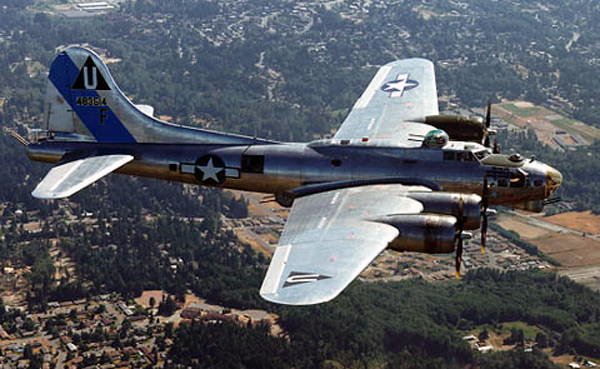Even though it wasn’t a revolutionary aircraft such as the B-29, the Boeing B-17 Flying Fortress is probably the most famous American bomber of World War 2 (compared to the B-29, it was twice as “light”, so to speak). At first lacking sufficient anti-fighter defence, this heavy bomber was enhanced and become known as the “Fortress” because of its great survivability.
The most renowned B-17, perhaps, is the Memphis Belle, which flew 25 bombing missions over hostile territory, before its crew got to go back to the USA as instructors. Many times, the B-17s would come back to their England base with only one engine working, crew members injured and a several damages, and would take off again a few weeks later, repaired but some would land in such a terrible state that they would simply go the dump. That speaks volume about the sturdiness of this aircraft.
Created in 1935, the Boeing B-17 entered service in 1941 (one must keep in mind that before that, the United States were not at war). The number of machine-guns equipping the Flying Fortress gradually reached 13. This allowed the planes to defend themselves, especially when flying in “boxes” formation – every angle would then be covered and the Axis’ fighters would have no place to hide when attacking.
More than 12,300 Boeing Flying Fortress were built.
| Type: | Heavy Bomber |
| Crew: | 10 to 13 |
| Powerplant: | Four 1250hp Wright Cyclone R-1820-65 |
| Max speed: | 323mph (520 km/h) |
| Ceiling: | 11,278m (37,000ft) |
| Range: | Over 3000 miles (4830km) |
| Weight (empty): | 16,206kg (35,728 lb) |
| Weight (loaded): | 29,759kg (65,600lb) |
| Wingspan: | 31.6m (103’9″) |
| Length: | 20.7m (67’11”) |
| Height: | 17 ft. 9 in. (5.6m) |
| Armament: | Between 9 & 12 M2 12.7mm (0.50″) Machine Guns, 1x 7.7mm (0.303″) machine gun, bombload upto 17,600 lbs (7,985 kg) |

